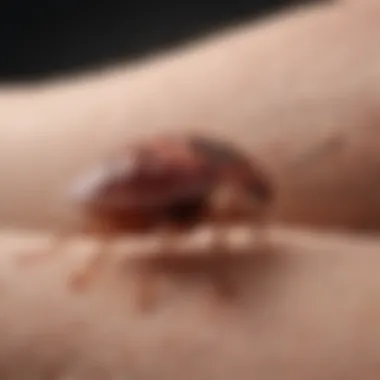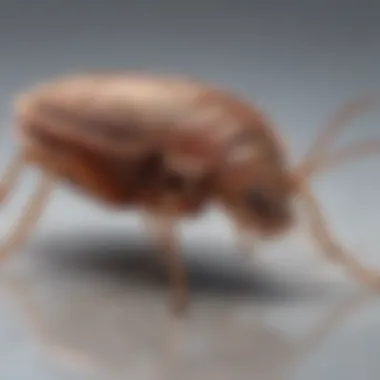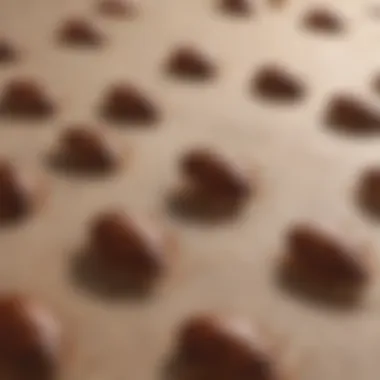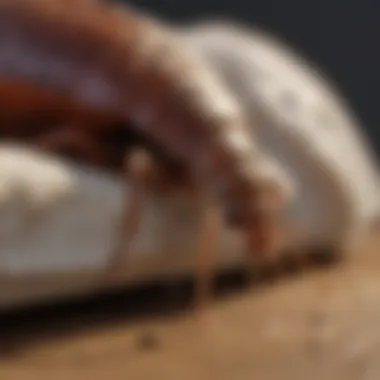Unveiling the Intricacies of Bed Bug Bites and Their Impact on Individuals


Preventive Pest Control Strategies
When it comes to keeping your home pest-free, implementing preventive pest control strategies is key to maintaining a healthy living environment. Starting with house exterior protection, it is crucial to seal any cracks and crevices that may serve as entry points for pests. Clearing debris around your property plays a significant role in preventing pests from finding harborage areas. Additionally, employing methods to stop pests from entering your home, such as installing door sweeps and screens, can be highly effective.
In terms of yard maintenance, incorporating essential yard care routines like trimming overgrown vegetation and removing standing water can deter pests from taking residence in your outdoor space. Implementing methods to keep your yard pest-free, such as using natural repellents or creating barriers, can further enhance your pest control efforts.
Turning to indoor cleanliness, adopting expert cleaning tips and techniques is essential for creating a pest-resistant environment inside your home. Regularly decluttering and vacuuming, sealing food containers, and fixing any leaks can go a long way in deterring pests from infesting your living space. Maintaining a consistent cleaning schedule can significantly reduce the risk of pest invasions.
Garbage disposal also plays a crucial role in pest prevention. Efficient waste disposal methods, such as securely sealing trash bags and using tightly covered bins, can help eliminate attractants for pests. Proper garbage disposal not only keeps your home clean but also minimizes the likelihood of pest infestations.
In addition to these standard preventive measures, exploring other innovative ways to safeguard your home against pests, such as utilizing natural deterrents like diatomaceous earth or installing ultrasonic pest repellent devices, can provide an added layer of protection. By being proactive and implementing a combination of these preventive pest control strategies, you can significantly reduce the risk of encountering pest-related issues in your home.
Introduction
Overview of Bed Bugs
Bed bugs, scientifically known as Cimex lectularius, are small, reddish-brown insects that feed on the blood of animals and humans, typically during the night. They are adept at hiding in cracks and crevices, making them challenging to eradicate once they infest a space. Bed bugs can multiply rapidly, leading to significant infestations if not addressed promptly and effectively.
Importance of Understanding Bed Bug Bites
Understanding bed bug bites is not just about recognizing the physical symptoms; it is also about grasping the psychological and emotional impact they can have on individuals. Beyond the discomfort of itching and red welts, bed bug bites can cause anxiety, stress, and sleep disturbances. By comprehending how bed bugs interact with humans through their bites, individuals can take proactive measures to protect themselves and their living environments.
Characteristics of Bed Bug Bites
Appearance of Bed Bug Bites
Small Red Welts
Small red welts are a distinctive characteristic of bed bug bites. These welts often appear as small, red bumps on the skin, signaling the presence of bed bugs in the vicinity. The appearance of these welts is crucial in identifying a potential bed bug infestation, as they tend to develop in a linear pattern, further emphasizing the need for prompt action. While unsettling, the appearance of small red welts serves as a visible indication of a bed bug issue, prompting individuals to address the situation promptly.


Linear Patterns
Linear patterns in bed bug bites occur due to the feeding habits of these pests. Bed bugs feed multiple times during the night, resulting in bites that align in a linear fashion on the skin. Recognizing these linear patterns is key in differentiating bed bug bites from other insect bites, enabling individuals to take appropriate measures for eradication and treatment. The presence of linear patterns in bed bug bites acts as a telltale sign of a possible infestation, prompting individuals to seek intervention to mitigate further infestations effectively.
Itching Sensation
The itching sensation associated with bed bug bites can range from mild to severe, depending on individual reactions. This sensation is often accompanied by redness and swelling at the bite site, causing discomfort and distress to affected individuals. Understanding the itching sensation helps in identifying bed bug bites and distinguishing them from other skin conditions, facilitating timely treatment and prevention strategies. Although uncomfortable, the itching sensation serves as a vital indicator of potential bed bug presence, prompting individuals to take necessary actions to address the issue promptly.
Identifying Symptoms of Bed Bug Bites
Understanding the key indicators of bed bug bites is crucial in effectively addressing and managing infestations. By properly identifying these symptoms, individuals can take prompt actions to alleviate discomfort and prevent further bites. Recognizing the signs early on can also assist in eradicating these pests before the situation escalates. This section delves into the significance of understanding symptoms related to bed bug bites within the context of this article, emphasizing the benefits of early detection and the considerations involved in accurate identification.
Common Signs and Symptoms
Redness and Swelling
The presence of redness and swelling is a hallmark characteristic of bed bug bites, often accompanying the affected area. This visual cue serves as a reliable indicator of a bed bug encounter and aids in pinpointing the exact locations of the bites. Redness and swelling contribute significantly to the overall topic of identifying symptoms as they act as primary visual markers, facilitating swift identification and targeted treatment. Despite causing discomfort, their prominence simplifies the process of differentiating bed bug bites from other skin issues. The unique feature of redness and swelling lies in their immediacy, providing clear cues that prompt action is necessary for effective management within this article's framework.
Itchiness
Itchiness is a prevalent symptom associated with bed bug bites, causing varying degrees of discomfort depending on an individual's sensitivity. This sensation plays a crucial role in alerting individuals to the presence of bed bug bites, prompting them to inspect and address the affected areas promptly. The key characteristic of itchiness lies in its ability to prompt individuals to seek relief, leading to the discovery and subsequent treatment of bed bug bites. While itchy sensations can be bothersome, they serve as an advantageous signal that prompts individuals to take necessary actions against bed bugs. However, excessive scratching due to itchiness can lead to secondary skin issues, underscoring the importance of timely intervention and care within the scope of this article.
Bite Marks
Bite marks left by bed bugs are unique imprints that characterize their feeding patterns on human hosts. These marks typically appear as small, red welts or bumps on the skin, revealing the aftermath of a bed bug's bite. Bite marks contribute significantly to the overall understanding of bed bug bites as they offer tangible evidence of an infestation. Their distinctiveness aids in differentiating bed bug bites from other insect bites, guiding individuals in seeking appropriate treatment and preventive measures. The advantage of bite marks lies in their specificity, clearly demarcating the sites of infestation with precision, enabling targeted management strategies. Although bite marks can be unsightly and itchy, their presence serves as a vital cue for addressing bed bug issues effectively in the context of this article.
Potential Allergic Reactions
Hives


Hives are inflammatory skin reactions marked by raised, red welts or plaques that may develop in response to bed bug bites among susceptible individuals. This specific aspect contributes significantly to the broader understanding of potential allergic reactions associated with bed bug bites within this article. The key characteristic of hives lies in their rapid appearance and resolution, highlighting the body's immune response to bed bug saliva. Their swift onset serves as a beneficial indicator for individuals to seek medical attention promptly, ensuring timely management and relief. However, hives can vary in severity, leading to discomfort and distress, underscoring the importance of recognizing and addressing these reactions within the context of this article.
Anaphylaxis
Anaphylaxis represents a severe, life-threatening allergic reaction that may occur in response to bed bug bites in rare cases. Understanding this specific aspect is crucial for individuals to grasp the potential risks associated with severe allergic responses to bed bug saliva. The key characteristic of anaphylaxis lies in its rapid progression, necessitating immediate medical intervention to prevent fatal outcomes. Its recognition as a rare but serious complication of bed bug bites underscores the importance of seeking professional help without delay. However, anaphylaxis can present challenges due to its sudden onset and escalating symptoms, highlighting the critical need for preparedness and awareness within the scope of this article.
Treatment of Bed Bug Bites
Home Remedies
When it comes to alleviating the symptoms of bed bug bites, home remedies play a significant role in providing relief. Within this segment, we will delve into the various home remedies that can aid in soothing the irritation caused by bed bug bites.
Topical Creams
Among the home remedies for bed bug bites, topical creams stand out as a popular choice. These creams are designed to alleviate itching and reduce redness, providing much-needed comfort to those affected by bed bug bites. Their quick absorption and soothing properties make them a go-to remedy for many individuals dealing with bed bug bites.
Cold Compress
Another effective home remedy for bed bug bites is the cold compress. Applying a cold compress helps to reduce inflammation and relieve the itching sensation associated with bed bug bites. The cooling effect not only numbs the affected area but also helps to calm the skin, promoting healing and comfort.
Oatmeal Baths
Oatmeal baths are known for their skin-soothing properties, making them an ideal home remedy for bed bug bites. The anti-inflammatory nature of oatmeal can help reduce itching and redness, providing relief to those experiencing discomfort from bed bug bites. Additionally, oatmeal baths are gentle on the skin, making them suitable for individuals with sensitive skin.
Medical Interventions
In cases where home remedies may not suffice, medical interventions are available to address the symptoms of bed bug bites more effectively. This section explores the use of medical treatments in managing the consequences of bed bug bites.
Antihistamines


Antihistamines play a vital role in alleviating allergic reactions and discomfort caused by bed bug bites. By blocking histamine receptors, antihistamines can reduce itching, redness, and swelling associated with allergic responses to bed bug bites. They are commonly recommended for individuals experiencing more severe reactions to bed bug bites.
Corticosteroids
Corticosteroids are another medical intervention employed to combat the inflammation and itching triggered by bed bug bites. These potent anti-inflammatory agents help reduce swelling and alleviate skin irritation, offering relief to individuals with persistent or severe reactions to bed bug bites.
Prevention Strategies for Bed Bug Bites
In this section, we delve into the crucial aspect of prevention strategies for bed bug bites in our comprehensive guide. Understanding and implementing effective prevention strategies are paramount in safeguarding against these pesky pests. By focusing on specific elements such as regular inspection of bedding, decluttering spaces, and sealing cracks and crevices, individuals can significantly reduce the risk of bed bug infestations.
Tips for Avoiding Bed Bug Infestations
Regular Inspection of Bedding
When it comes to preventing bed bug infestations, regular inspection of bedding plays a pivotal role. By routinely checking bedding for any signs of bed bugs such as fecal stains, shed skins, or actual bugs, individuals can detect infestations at an early stage. This proactive approach not only helps in eradicating bed bugs promptly but also prevents their spread to other areas of the home.
Decluttering Spaces
Decluttering spaces is another essential aspect of bed bug prevention. Clutter provides ample hiding spots for bed bugs, making it challenging to spot and eliminate them. By decluttering living areas and reducing items where bed bugs can hide, individuals can make their homes less hospitable to these pests. This simple yet effective step is key in minimizing the risk of bed bug infestations.
Sealing Cracks and Crevices
Sealing cracks and crevices is a crucial preventive measure against bed bugs. These pests can squeeze into tiny openings in walls, furniture, or baseboards, making it imperative to seal any potential entry points. By sealing cracks and crevices with caulk or appropriate sealants, individuals create a barrier that deters bed bugs from infiltrating living spaces. This meticulous step significantly reduces the chances of a bed bug infestation and promotes a bug-free environment.
Travel Precautions
When traveling, taking proper precautions is essential to avoid bringing bed bugs back home. In this section, we highlight two vital strategies for travelers to prevent bed bug exposure.
Inspecting Hotel Room
One of the first tasks travelers should undertake upon checking into a hotel is inspecting their room for any signs of bed bugs. This includes checking behind headboards, along mattress seams, and in furniture crevices. By conducting a thorough inspection, individuals can identify potential bed bug hotspots and take necessary action to avoid contact with these pests.
Laundering Clothes
After returning from a trip, laundering clothes promptly is critical to prevent any bed bugs from hitchhiking back home. Washing clothes in hot water and drying them on high heat helps kill any potential bed bugs that may have attached themselves to clothing. This simple yet effective measure ensures that travelers do not inadvertently bring bed bugs into their living spaces, helping maintain a bed bug-free environment.



